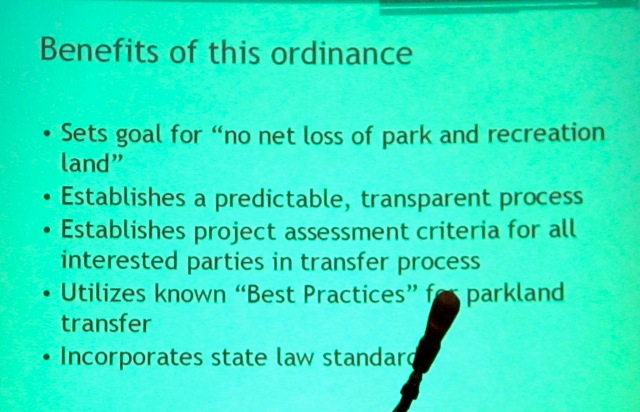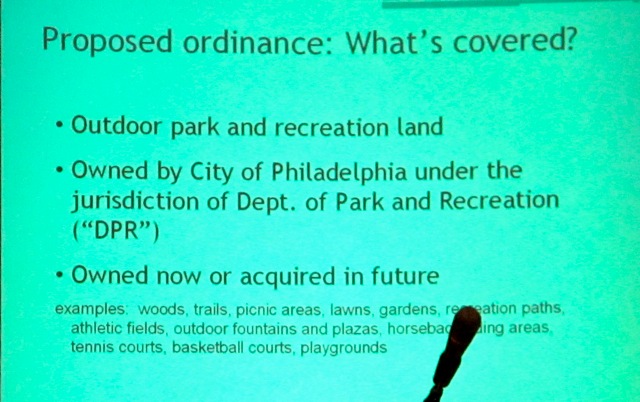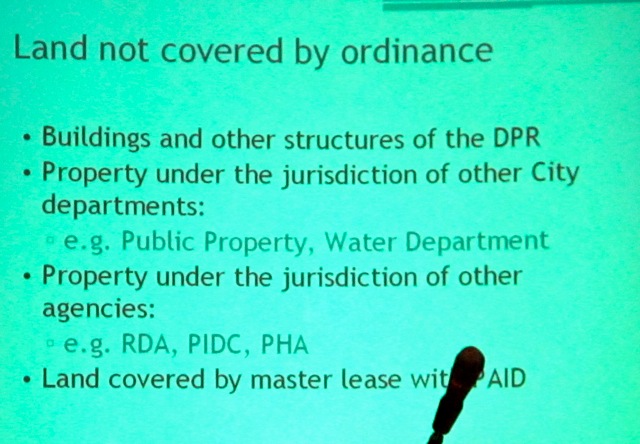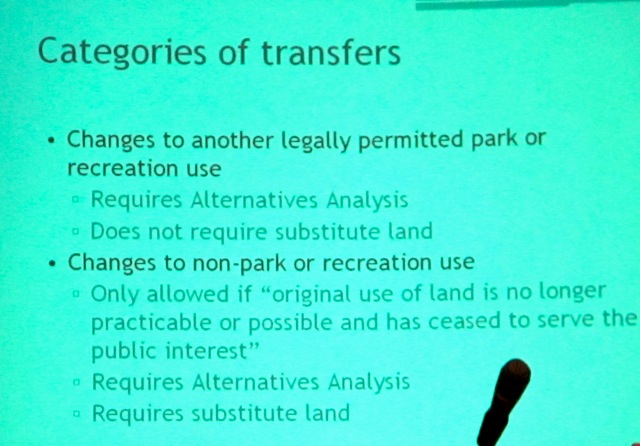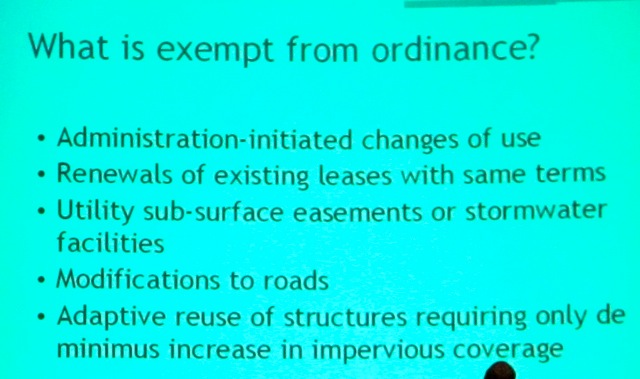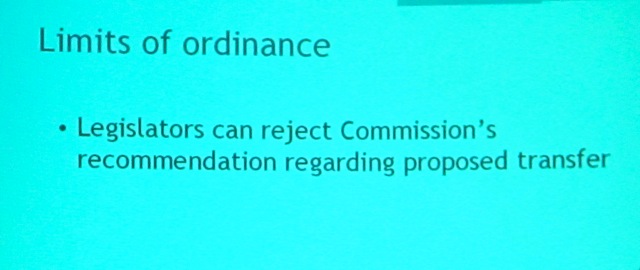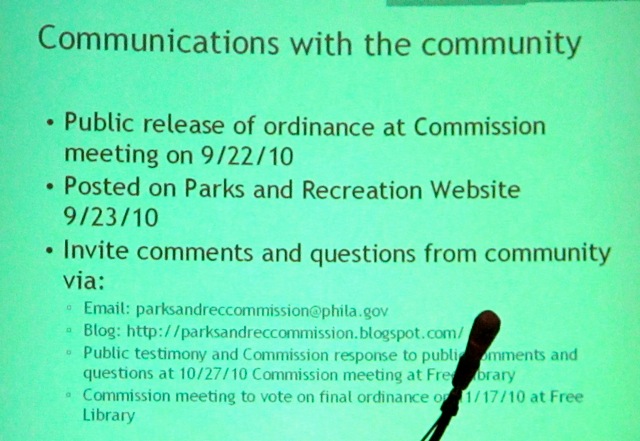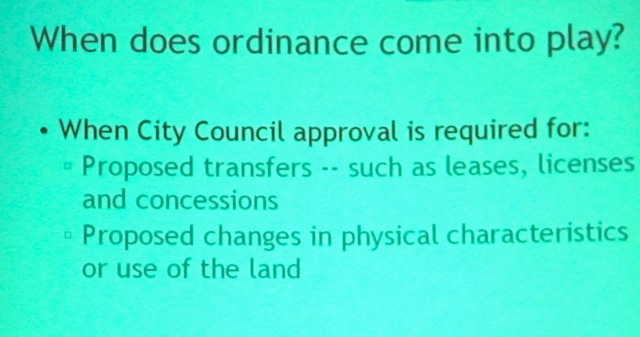Parks and Recreation moves ahead on land disposition ordinance
On Wednesday evening, for its fourth meeting since being formed, the new Parks and Recreation Commission offered the first public glimpse of its proposed Open Land Protection Ordinance. The ordinance is part of broader land use guidelines required by the City Charter at the formation of the Commission.
Commission Chair Nancy Goldenberg introduced a presentation outlining the proposal by assuring the 30 or so park activists in attendance that “we are not at all presuming that what we’re presenting tonight is final.”
She added that the group will also put together a FAQ fact sheet on the proposal, hold a special public meeting about it on Wednesday, Oct. 27 (at 6 p.m. in the Free Library’s Skyline Room), and aim to have a final draft of the ordinance in time for its next regularly scheduled meeting on Wednesday., Nov.17, also at the Free Library.
After her introduction of the whys and wherefores of the ordinance, Goldenberg handed off the presentation to Debra Wolf Goldstein, chair of the Commission’s Land Use Committee. Wolf Goldstein offered a brief look (see slideshow) at the benefits and goals of the land disposition provisions (“no net loss of parks and recreation land” and “establish a predictable and transparent process” for land disposition transactions) and detailed what would and would not be covered under the ordinance.
All outdoor parks and recreation land owned by the City of Philadelphia would be subject, while buildings and other structures would not, nor would property under the jurisdiction of other city departments, such as the Philadelphia Water Department, or other independent agencies, such as PDIC or the RDA.
The next few slides examined the specifics of when the ordinance would come into play. Triggers proposed include any transfer or exchange of land that would require City Council approval; while those not requiring such approval, those having to do with road modifications or utilities or adaptive reuse, would not.
Transfers would be categorized in two ways: changes to another legally permitted park or recreation use, and those to another non-park or recreation use. Those meeting the former criterion would require the submission of an Alternatives Analysis; while the latter category requires that paperwork, as well as the giveback of substitute land.
Swaps in the second category are subject to a “very, very high bar,” emphasized Wolf Goldstein. The “original use” of such land would have to be demonstrated as “no longer practicable or possible and [have] ceased to serve the public interest.”
The Alternatives Analysis must present a case for why and how the land is no longer viable in its original use, present reasonable alternatives that have been considered, and, if required, identify substitute land of equal size, value, usefulness (to parks and recreation purposes), and, if feasible, be in the same or adjacent councilmanic district.
Wolf Goldstein concluded with a look at what would happen next in the process — the Alternatives Analysis is reviewed by the Commission and City Council, the Commission offers recommendations; a public hearing is held; Council approves or denies the request. As per the Charter, Goldstein said, legislators can reject the Commission’s recommendations, but must give them “substantial weight.”
Carol Rice, chair of the Communications Committee, wrapped up by reiterating the various ways in which the public can give input on the proposals, including by email (parksandreccommission@phila.gov), blog (http://www.parksandreccommission.blogspot.com), and the by attending the October public meeting. She added that the proposal is now on both the Fairmount Park and Department of Recreation web sites. In response to a questioner, Goldenberg also mentioned that a press release about it would be disseminated to all local media.
Another audience member asked how upcoming zoning changes would impact the ordinance. The Commission’s legal counsel, Larry Copeland, who is also advising the Zoning Code Commission, responded that he is “trying to dovetail” the work of both Commissions.
Revenue Enhancement Committee Chair Pete Hoskins next reported on an upcoming study that will focus on current and potential concessionaire agreements. Funded by the William Penn Foundation, the work “wants to ensure that concessions are meeting the needs of the public,” he said. It will also, of course, examine ways for the system to generate more income.
Rice returned to talk a bit more about other communications efforts, including the idea of developing workshops to help parks and recreation centers realize their potentials. She also mentioned that the system is “looking to bring in” Peter Harnik, a noted author and consultant on park resurgence, and the director of the Center for City Park Excellence at the Trust for Public Land.
Commissioner Mike DiBerardinis then presented an update on the department’s merger, as well as reported on this summer’s outcomes, and progress on the system’s involvement with Greenworks.
The department is using the late Fall/early Winter downtime to complete the integration of all formerly separate staff, operations, and facilities, DiBerardinis said. Summer highlights included the fact that 70 of the city’s 72 pools were opened (two being inoperable), and that more than 1 million users enjoyed them, up from 600,000 in 2009.
DiBerardinis restated the three Greenworks goals that the department has adapted — the planting of 300,000 new trees, the acquisition of 500 acres of new open space, and a commitment to urban agriculture. He said that almost $5 million had been obtained toward reaching the tree planting goal and that two big city employers, the University of Pennsylvania and Independence Blue Cross, are working with their employees to encourage them to plant trees on their own properties.
DiBerardinis added that the department was conducting an extensive analysis of available public and private land toward the second goal, adding that this process had potential to become a “national model.”
Questions and comments during the 90-minute meeting ranged from the generally disgruntled (attendees expressed concerns about the new Barnes site, about deer culling, and about a local farm) to specifics about the proposal (whether the land acquisition studies would take into consideration past park land that had been lost, whether the no net loss policy applies to land transferred to other agencies, and whether the ordinance exclude properties within historic landmarks).
Goldenberg encouraged attendees to submit them in written form. “It’s a great challenge to give you a pat answer,” she said, before concluding the meeting with a roundup of recent park events, triumphs, and activities.
The list was, she said, “just the tip of the iceberg,” and included the inauguration of a Philadelphia Urban Youth Baseball Academy (only the fourth in the nation), renovations at Hunting Park, a new piece of artwork at Elmwood Park, and a new partnership with the Independence Visitors Center which will strengthen the offerings of the Fairmount Park Welcome Center at LOVE Park.
Contact JoAnn Greco at www.joanngreco.com
Check out her new online magazine, TheCityTraveler at www.thecitytraveler.com
WHYY is your source for fact-based, in-depth journalism and information. As a nonprofit organization, we rely on financial support from readers like you. Please give today.



